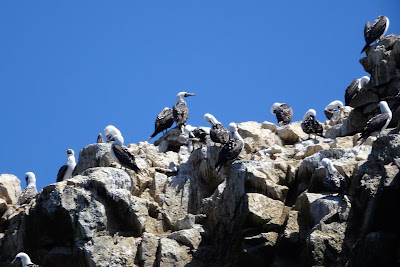After one day at sea, we’ve cruised in an overall northwest direction along the South American coast to our first port in Peru -- General San Martin – for a visit to Paracas and the Ballestas Islands.
This port was named after General José de San Martin, Peru’s most revered historical figure. It was he who led an army across the Andes Mountains from Argentina. From what we’ve read, we understand that after liberating Chile, he organized a naval fleet which came ashore near where we are today. They marched into Lima, capturing the city and declaring independence from Spain for all of Peru in July of 1821.
Once again, we’re in dry, desert conditions, as it looks really desolate in and around the port. Almost all the surrounding area is protected as part of the large Paracas National Reserve, which we were told encompasses some 827,000 acres. Following is a picture taken of the local terrain from our balcony window. There’s a total lack of anything green around here --

For today, we signed up for a ship excursion called, “Bellestas Islands Motorboat Cruise.” When we were here five years ago, we went on the same excursion and had such good memories of that trip, that we wanted to do it again. We boarded a nice large, comfortable bus that took us to the small village of Paracas. There were four buses for our tour group, and each bus carried forty passengers. We walked to an attractive new docking area adjacent to the Hotel Liberator Paracas, where we boarded four 40-person, open-air speedboats. The islands are uninhabited and off-limits to visitors, but the speedboats were able to get us very close. Our friends Butch & Diane joined us on the trip.


On the boat ride out to the islands, they stopped so we could look at a large, mysterious candelabra-shaped petroglyph on the side of a cliff. These lines were scraped into the desert’s crust and have been there for perhaps thousands of years; nobody knows for sure why they’re there, but there are lots of theories.
There are three adjacent Ballesta Islands that are collectively known as
The Little Galapagos of Peru. We spent more than an hour circling the guano-covered islands, observing the wildlife. There were thousands of flamingos, pelicans, cormorants, Peruvian boobies, Humboldt penguins, and Inca terns. Our guide, said that there are 150 species of birds that are seen here.
There were also more sea lions than you could possibly imagine. They seemed to like to crawl around and sleep on rocky spots or by the many caves and arches near the water line.
Most interesting was the “maternity beach” with hundreds of mothers and baby sea lions, with the babies crying out to their mothers plaintively.
We also enjoyed watching a mother sea lion teaching her baby to swim in the open water.
Our 30-minute drive, each way, to and from port, was through the Paracas National Reserve. There were many spectacular rolling hills, totally devoid of vegetation. There’s almost no rainfall here ever, except in an extremely unusual event. We were told that Paracas means “sandstorm” in the local language. In many ways, it looks like pictures of Mars that we’ve seen.
We were every glad to have taken the Ballestas Islands tour again, and it was a busy day snapping pictures.
Two of our world-cruise friends, Jim and Lois, took a different shore excursion today to see the famous Nazca Lines from a small plane. They reported that it was a great experience to see the ancient “geoglyphs” in the Nazca Desert from the air. The air was very clear and they were able to see everything perfectly. They said that the geoglyphs were bigger than expected, and they also enjoyed the museum which was co-located with the airport.
It’ll be a short cruise along the Peruvian coast tonight, as it isn’t far from our current location to our next in the busy port of Callao, Peru.
Jim & Ginny













No comments:
Post a Comment